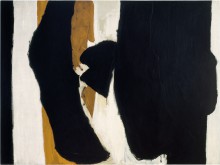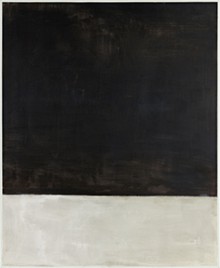Louise Nevelson
Sky Garden 1959-1964

© 2014 Estate of Louise Nevelson / Artists Rights Society (ARS), New York. Reproduction, including downloading of ARS member works is prohibited by copyright laws and international conventions without the express written permission of Artists Rights Society (ARS), New York.
Audio Description (02:56)
Full Audio Transcript (Expand)
Sky Garden
The name of Louise Nevelson’s artwork, Sky Garden, might evoke something bright and airy, but this wood sculpture, with every surface spray painted a uniform matte black, is anything but. It stands just over eight feet tall and is five feet wide. Nevelson created the sculpture between 1959 and 1964 using wood that had been discarded and was recycled into this work of art. Built from twelve differently-sized crates in four uneven columns, the sculpture is like a fantastical, asymmetrical curio cabinet that’s nearly one and a half feet deep and filled with an array of found wood objects painted in the exact same matte black as the cabinet that houses them. A few compartments have doors wide open, while others lack doors altogether. Several have one or two thin sheets of wood in place of doors that are trimmed to different sizes to create windows to the items inside. The sheets fit tightly into the corners, and some have curved edges in front of the openings to the crates. In the bright, carefully-aimed lights of the museum, the viewer can clearly discern everything in all of the arrays of objects being showcased.
These found wood objects are a variety of shapes and sizes: round, rectangular, thin, thick, smooth cutouts, or lumpy scraps. Rather than all resting on the floor of each crate or on shelves within them, many of these found objects are piled and glued to the back and side walls, giving them the appearance of floating. Some of the objects in the cabinet may feel familiar, like long, slender strips of lumber, a segment of handrail for indoor stairs, pieces of floor planks, or hunks of firewood that appear burned thanks to the thick black paint coating them. The use of only one color paint throughout might seem as if it would flatten the sculpture overall, but the medley of items on display gives it tremendous texture and depth by creating shadows at odd angles. The cabinet stands atop a thick rectangular wooden base, the only part of it that feels truly even and steady.
Taken as a whole, the uneven nature of the sculpture is impossible to ignore and at first may make it feel haphazard in its design. Moving in to inspect it more closely, it becomes clear that the wooden bits and pieces were carefully chosen and meticulously arranged. Like a backyard garden, this piece is bounteous, with a range of sizes and shapes of both the crates and the found objects. Other than a few metal door hinges, Sky Garden is made entirely of wood, which is perhaps the perfect natural material for building a garden of the night sky.
Louise Nevelson constructed her sculpture Sky Garden using pieces of discarded wood. As a whole, Sky Garden resembles a series of modular cabinets, each containing a group of strange but alluring objects. As she did with many of her sculptures, the artist covered Sky Garden with a thick coat of black paint. Nevertheless, by carefully placing each wooden piece, Nevelson was able to create subtle patterns of light and shadow. Close examination of the sculpture reveals wooden table legs, banisters, and jagged planks. Nevelson began making these wooden constructions in the 1950s after relocating to New York City and taking classes at the Art Students League. These large-scale sculptures sometimes approach a monumental scale, like Sky Garden, or grow into environments, taking over full rooms.
Nevelson spent much of her career in New York City, but she shares a sense of isolation with the artists in this gallery. She preferred to work on her sculptures in solitude. Sky Garden gives the impression of entering Nevelson’s private world—a twilight space of the artist’s own making. As Nevelson once said of her work: “My total conscious search in life has been for a new seeing, a new image, a new insight. This search not only includes the object, but the in-between place—the dawns and the dusks, the objective world, the heavenly spheres, the places between the land and sea.”
-Amber Harper, PhD candidate in the Department of Art & Art History
From Left of Center, opened Sept 20, 2019
Reflecting on the transformative power of the black enamel paint she used to cover her assemblages, Nevelson once explained: “When I fell in love with black, it contained all color. It wasn’t a negation of color. It was an acceptance. Because black encompasses all colors. Black is the most aristocratic color of all . . . . You can be quiet and it contains the whole thing. There is no color that will give you the feeling of totality. Of peace. Of greatness. Of quietness. Of excitement.”
Sky Garden is composed of an eclectic mix of found wooden objects arranged in crates that have been stacked to create a monumental relief sculpture. The hinged doors suggest a cabinet of curiosities in which we might expect to find a collection of remarkable objects displayed. But the monochromatic finish estranges the objects from the associations they may originally have carried, subsuming them in an ocean of black.
-Sidney Simon, PhD ‘18
Redefining Feminism in Modern Art
Sky Garden marries light, shadow, and color, making us dive deeper into the frames of the sculpture to decipher what they contain. Nevelson constructed Sky Garden using discarded pieces of wood, deriving from her father’s practice as a carpenter, constructing multiple worlds of curiosities in one with the use of black as the only color. She considers black to be the totality of all colors, not as a negation but as an acceptance and triumph.
While facing criticism that her art was too “masculine,” Nevelson advocated for the arts as a genderless field, redefining feminine art to defy criticism and gender separation. Sky Garden is one of many tributes to the strength of intimacy and is a work that pushes back against the traditional guidelines for what a female artist should be making in the twentieth century.
—Irmak Ersoz ‘24






![Collage and Ink Figure Study No. 35 [Joan Brown], 1963](https://anderson.stanford.edu/wp-content/uploads/2017/07/MN.1963.DWG_.093rev-220x218.jpg)
